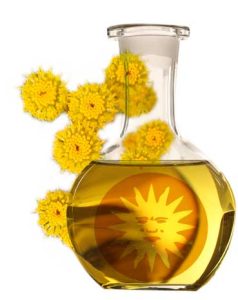Camomille Essential Oil (Santolina Chamaecyparissus)
At Esencias Lorente, we proudly present our Chamomile essential oil, extracted with the highest quality and purity. Sourced from our carefully selected plantations, this oil is steam-distilled in stainless steel stills, ensuring its integrity and purity. Trust in our expertise to provide you with the finest chamomile essence.
Description: Clear liquid essential oil as well as yellow greenish coloured . It has a floral and soothing smell.
Bloom: This plant is wild and it blooms in May..
Growth: It is grown for its essential use, it’s picked in Castilla La Mancha and in a lesser extent in the Baza Mountains.
Composition: It is composed by Alpha-Pinene, Isobutyl-Butyrate, Isoamyl Angelate.
Use: This essence is mainly used in cosmetics.
TECHNICAL TABLE OF ESSENCE
ORGANOLEPTIC INFORMATION
PHYSICAL-CHEMICAL INFORMATION
CHEMICAL COMPOSITION (Active Principles)
Chamomile, commonly known as “manzanilla” in Spanish, with the scientific name Matricaria chamomilla or Matricaria recutita, is different from the plant Santolina chamaecyparissus, known as “cáscara sagrada” or “algodonosa.” The former, Matricaria chamomilla, is the variety most commonly used for the extraction of chamomile essential oil, which typically includes components such as:
- α-bisabolol (or bisabolol): A primary component known for its anti-inflammatory, healing, and soothing properties for the skin.
- Bisabolol Oxide (-)-α-bisabolol): A compound found alongside bisabolol, contributing to its anti-inflammatory and healing properties.
- Azulene Oxide (or chamazulene): Formed during the distillation process and responsible for the blue color that chamomile essential oil may have. It possesses anti-inflammatory and soothing properties.
- Farnesene: Contributes to anti-inflammatory and antioxidant properties.
- Pinene and other terpenes: Contribute to the characteristic aroma and may have antimicrobial properties.
These are some of the chemical components typically found in Matricaria chamomilla (chamomile) essential oil. Remember that the exact composition may vary depending on the cultivation region, climatic conditions, harvest time, and the method of essential oil extraction.
Description of Chamomile (Santolina chamaecyparissus)
Chamomile (Santolina chamaecyparissus) is a perennial aromatic plant belonging to the Asteraceae family. Despite its common name being “chamomile,” it is not related to true chamomile (Matricaria chamomilla or Chamaemelum nobile), which is commonly used in infusions.
Chamomile has a compact and bushy growth habit, reaching a height of about 30-60 centimeters. Its leaves are small, linear, narrow, silver-gray in color, and arranged oppositely along its stems. This plant is valued for its aromatic foliage and its yellow floral heads that resemble small daisies, although it does not have the same uses as true chamomile.
Uses of Chamomile (Santolina chamaecyparissus):
- Gardening and Ornamentation: Due to its compact appearance and the decorative characteristics of its yellow flowers, chamomile is commonly cultivated in gardens as an ornamental plant, often in borders, rockeries, or flower beds.
- Aromatic: Its leaves emit an herbal aroma, and some people have used its dried leaves in sachets or pillows to release their fragrance in closets or indoor spaces.
- Traditional Use: Although not commonly used for medicinal or culinary purposes, in some traditions, it has been used to prepare infusions or poultices, although its use for such purposes is less widespread than that of true chamomile.
It is important to note that Santolina chamaecyparissus is not the traditionally used chamomile for infusions or medicinal purposes, so its consumption or application for therapeutic purposes should be approached with caution.
